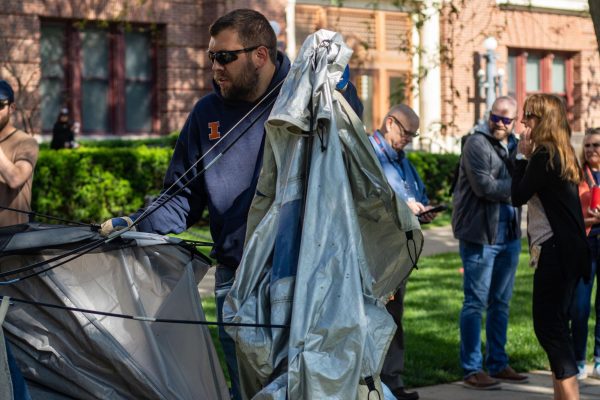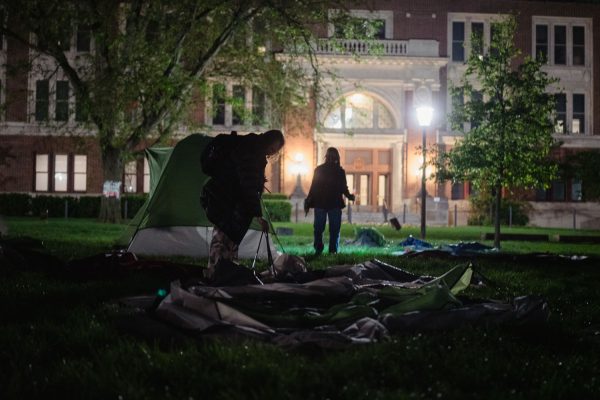Santa Fe shop serves heirloom chocolate drinks
July 18, 2008
SANTA FE, N.M. – Walk in, take a whiff. Ahhhh, chocolate. Now take a sip. Mmmmm, high-octane chocolate with hints of chili. Or rose. Or nutmeg. Or almond.
Welcome to the Kakawa Chocolate House and the world of Mark Sciscenti – chocolate historian, chocolate alchemist, chocolate artisan, chocolate lecturer, baker, herbalist.
He says that as far as he knows, his 3-year-old emporium is unique in the U.S., serving 23 chocolate elixirs. And these are not your every day sort of drinks.
Many of them are Mesoamerican, based on recipes gleaned from anthropological and historical documents. Such as a 1551 manuscript written by an Aztec physician who was educated in Latin and illustrated by an Aztec artist.
Other elixirs are Colonial American or centuries-old European recipes, Sciscenti says.
Get The Daily Illini in your inbox!
“People walk out of a coffee shop strung-out. Here, they walk out blissed-out,” Sciscenti says.
Customers in the brown-stuccoed adobe building are cosseted in rustic Mexican-made leather chairs in two rooms with wood floors and wood-beamed ceilings.
John Henderson, an anthropology professor at Cornell University, says chocolate drinks were used as a social grease by cultures in Mesoamerica – the region that includes Mexico and parts of Central America.
“During religious ceremonies, weddings, funerals or just when you want to impress the guests, chocolate was the right thing to serve,” he says.
Tere Lee, a 52-year-old landscape designer from Canoncito, says she comes to Kakawa every couple of weeks not just for the chocolate, but also the atmosphere.
“You don’t want to leave. You take the spirit of the place with you,” she says.
The Kakawa drinks, which are mostly water-based, are sold under unusual names that run from A-to-Z – Aztec Warrior, Mayan Full Spice, 1644 Spanish, 1790s Jeffersonian, Zapoteca.
“I can’t drink American, or Mexican drinking chocolate for that matter, because it’s too milky and too sweet and not enough chocolate and not a whole lot of flavor,” says Sciscenti.
Sciscenti says water “allows the true flavors of the chocolate to come forward, and all the nuanced flavors can build up into a crescendo on the palate, on the tongue, and have a long-lasting, lingering effect,” he says.
Dairy fats in milk or cream coat the taste buds “and so you’re not going to get as many flavors of the chocolate coming forward,” he says.
He says he uses only the finest dark chocolates – a mix from “unparalleled” criollo or “extremely flavorful” trinitario types of cacao.
Criollo’s roots are Mesoamerican, grown in Mexico and Central America, Sciscenti says.
Trinitario – dating to about 1750 – is a hybrid of criollo and the hardier – but less flavorful – forastero from the upper Amazon, he says.
He followed his own taste buds in mixing and matching ingredients such as cinnamon, cloves, black pepper, orange blossoms, rose or almonds. And chili. Many of Sciscenti’s drinks are slightly sweetened, mainly with agave nectar.
“I wanted to mimic the same flavors that the Mesoamericans were drinking,” Sciscenti says.
“Quite a few of the Mesoamerican drinks or the Mayan drinks that I make do have chilies because chilies were an indigenous and traditional and universally popular ingredient in drinking chocolate,” he says.
The drinks usually are served hot, but can be ordered iced during the summer.
Aztecs would drink their chocolate either at room temperature or cold, Sciscenti says.
“Often times they would have runners who would go up into the mountains and grab ice and run back with it and chop it up and pour chocolate over it,” he says.
Henderson says most of what is known about the oldest chocolate recipes comes from the Aztecs, dating back to when Spaniards invaded Mesoamerica in the early 16th century.
The Aztecs would have added chili peppers, flowers and herbs, says Henderson, whose research indicates residents of Central America were enjoying chocolate drinks more than 3,000 years ago, much earlier than previously thought.
Drinking chocolate spread to Europe during the 16th and 17th centuries, he says. Milk was not used in European drinks until the late 18th century.
No blenders are used at Kakawa. Just low-tech fruit jars containing the elixir ingredients. Shaken, not stirred.
“The one thing that carried over very strongly into Europe was frothing,” Henderson says.
“You’d grind up the cocoa beans after they were fermented, mix them typically with water, and froth that – either pour it from one jar into another or use kind of a beater stick between the hands,” he says.
Henderson says chocolate was such a prized commodity in Mesoamerica that cocoa beans were used as money.
“The joke in Mesoamerica that money grew in trees was literally true,” he says.
But making a buck is not Sciscenti’s highest priority. His true passion is turning people on to fine chocolate.
“The chocolate is at the forefront. I love it,” he says.






